 W
WAnchiornis is a genus of small, four-winged paravian dinosaur. The genus Anchiornis contains only the type species Anchiornis huxleyi, named for its similarity to modern birds. Anchiornis fossils have been only found in the Tiaojishan Formation of Liaoning, China, in rocks dated to the Late Jurassic, about 160 million years ago. Anchiornis is known from hundreds of specimens, and given the exquisite preservation of some of these fossils, it became the first Mesozoic dinosaur species for which almost the entire life appearance could be determined, and an important source of information on the early evolution of birds. Anchiornis huxleyi translates to "Huxley's near-bird" in Greek.
 W
WAorun (pron.:"AW-roon") is an extinct genus of carnivorous theropod dinosaur first discovered in 2006, with its scientific description published in 2013. It is one of the oldest known coelurosaurian dinosaurs and is estimated to have lived ~161.6 million years ago during the Late Jurassic Period. It is the fifth theropod discovered from Wucaiwan.
 W
WThe Beipiao Formation contains coal measures dated to the Early Jurassic period. Its mainly located in Xinglong County, Hebei Province
 W
WBellusaurus was a small short-necked sauropod dinosaur from the Middle Jurassic which measured about 4.8 metres (16 ft) long. Its fossils were found in Shishugou Formation rocks in the northeastern Junggar Basin in China.
 W
WBienosaurus is a dubious genus of thyreophoran dinosaur from the Lower Jurassic Lower Lufeng Formation in Yunnan Province in China.
 W
WCaihong is a genus of small paravian theropod dinosaur from China that lived during the Late Jurassic period.
 W
WThe Chuanjie Formation, is a geological formation in Yunnan, China. It dates back to the Middle Jurassic. It was formerly referred to as being the lower member of the "Upper Lufeng" as opposed to the underlying "Lower Lufeng" now referred to as the Lufeng Formation. Tracks of theropods and sauropods, as well as thyreophorans are known from the formation.
 W
WDaanosaurus was a genus of dinosaur. It was a brachiosaurid sauropod which lived during the Late Jurassic. It lived in what is now China, and was similar to Bellusaurus. When it was described, Daanosaurus was placed in the Bellusaurinae, a sub-family of Brachiosauridae that Dong Zhiming had raised in 1990 to house Bellusaurus, or the Klamelisauridae, used to house Klamelisaurus, possibly Dannosaurus and Abrosaurus. More recently, other authors have placed Daanosaurus in the Eusauropoda.
 W
WDendrorhynchoides was a genus of anurognathid pterosaur containing only the holotype species D. curvidentatus that is known from the Middle Jurassic Tiaojishan Formation of Qinglong, northern Hebei Province, China.
 W
WDouzhanopterus is an extinct genus of monofenestratan pterosaur from the Late Jurassic of Liaoning, China. It contains a single species, D. zhengi, named by Wang et al. in 2017. In many respects, it represents a transitional form between basal pterosaurs and the more specialized pterodactyloids; for instance, its tail is intermediate in length, still being about twice the length of the femur but relatively shorter compared to that of the more basal Wukongopteridae. Other intermediate traits include the relative lengths of the neck vertebrae and the retention of two, albeit reduced, phalanx bones in the fifth digit of the foot. Phylogenetically, Douzhanopterus is nested between the wukongopterids and a juvenile pterosaur specimen from Germany known as the "Painten pro-pterodactyloid", which is similar to Douzhanopterus in many respects but approaches pterodactyloids more closely elsewhere.
 W
WFortiholcorpa paradoxa is an extinct species of scorpionfly (Mecoptera) from the Middle Jurassic of China. It is the only known species of its genus.
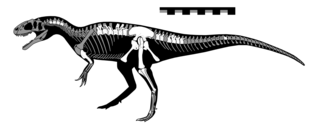 W
WGasosaurus is a genus of tetanuran theropod that lived approximately 171.6 to 161.2 million years ago during the middle of the Jurassic Period. The name "Gasosaurus" is derived from the English "gasoline" and the Greek σαῦρος. Only one species is currently recognised, G. constructus, from which the specific name honours the gasoline company that found the Dashanpu fossil quarry in Sichuan Province, China, now named as the Lower Shaximiao Formation.
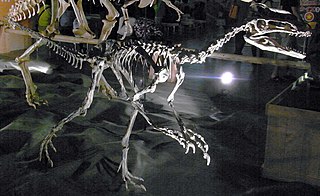 W
WGuanlong (冠龍) is a genus of extinct proceratosaurid tyrannosauroid from the Late Jurassic of China. The taxon was first described in 2006 by Xu Xing et al., who found it to represent a new taxon related to Tyrannosaurus. The name is derived from Chinese, translating as "crown dragon". Two individuals are currently known, a partially complete adult and a nearly complete juvenile. These specimens come from the Oxfordian stage of the Chinese Shishugou Formation.
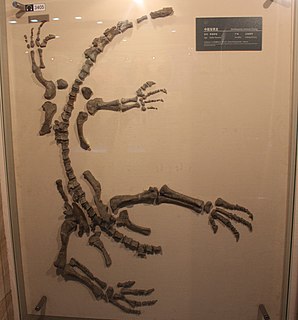 W
WGyposaurus is a genus of basal sauropodomorph dinosaur from the early Jurassic of South Africa. It is usually considered to represent juveniles of other prosauropods, but "G." sinensis is regarded as a possibly valid species.
 W
WThe Haifanggou Formation is a fossil-bearing rock deposit located near Daohugou village of Ningcheng County, in Inner Mongolia, northeastern China.
 W
WHaplocheirus is a genus of alvarezsauroid theropod dinosaur. It is the oldest known alvarezsauroid, predating all other members by about 63 million years. Haplocheirus was described in 2010 from a fossil specimen found from the 160-million-year-old Shishugou Formation in the Junggar Basin of northwestern China. The type species is H. sollers, meaning "simple-handed skillful one", referencing its hypothesized behavior of using its three-fingered hands for activities that other alvarezsauroids could not perform, such as catching prey.
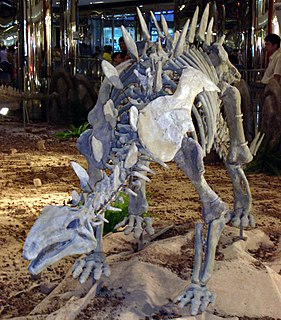 W
WHuayangosaurus is a genus of stegosaurian dinosaur from the Middle Jurassic of China. The name derives from "Huayang" (華陽), an alternate name for Sichuan, and "saurus", meaning "lizard". It lived during the Bathonian to Callovian stages, around 165 million years ago, some 20 million years before its famous relative, Stegosaurus appeared in North America. At only 4.5 metres long, it was also much smaller than its famous cousin. Found in the Lower Shaximiao Formation, Huayangosaurus shared the local Middle Jurassic landscape with the sauropods Shunosaurus, Datousaurus, Omeisaurus and Protognathosaurus, the ornithopod Xiaosaurus and the carnivorous Gasosaurus. It was found in Huayang in China.
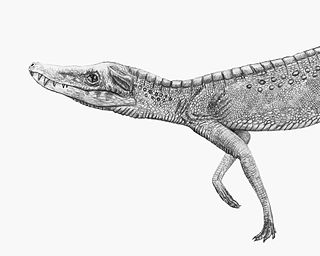 W
WJunggarsuchus is an extinct genus of sphenosuchian crocodylomorph from the Middle Jurassic of China. The type species is J. sloani.
 W
WKlamelisaurus is a genus of herbivorous sauropod dinosaur from the Middle Jurassic Shishugou Formation of China. The type species is Klamelisaurus gobiensis, which was named by Zhao Xijin in 1993, based on a partial skeleton discovered in 1982 near the abandoned town of Jiangjunmiao. Zhao described Klamelisaurus as the only member of a new subfamily, Klamelisauridae, among the now-defunct primitive sauropod order Bothrosauropodoidea. Since Zhao's description, Klamelisaurus received limited attention from researchers until Andrew Moore and colleagues redescribed it in 2020.
 W
WKryptodrakon is an extinct genus of pterodactyloid pterosaur from the Middle to Late Jurassic boundary of China, with an age of approximately 162.7 million years. It is known from a single type species, Kryptodrakon progenitor. The age of its fossil remains made Kryptodrakon the basalmost and oldest pterodactyloid known to date.
 W
WLimusaurus is a genus of theropod dinosaur that lived in what is now China during the Late Jurassic, around 161 to 157 million years ago. The type and only species Limusaurus inextricabilis was described in 2009 from specimens found in the Upper Shishugou Formation in the Junggar Basin. The genus name consists of the Latin words for "mud" and "lizard", and the species name means "impossible to extricate", both referring to these specimens possibly dying after being mired. Limusaurus was a small, slender animal, about 1.7 m in length and 15 kg (33 lb) in weight, which had a long neck and legs but very small forelimbs. It underwent a drastic morphological transformation as it aged: while juveniles were toothed, these teeth were completely lost and replaced by a beak with age. Several of these features were convergently similar to the later ornithomimid theropods as well as the earlier non-dinosaurian shuvosaurids.
 W
WThe Lufeng Formation is a Lower Jurassic sedimentary rock formation found in Yunnan, China. It has two units: the lower Dull Purplish Beds/Shawan Member are of Hettangian age, and Dark Red Beds/Zhangjia'ao Member are of Sinemurian age. It is known for its fossils of early dinosaurs. The Dull Purplish Beds have yielded the possible therizinosaur Eshanosaurus, the possible theropod Lukousaurus, and the "prosauropods" "Gyposaurus" sinensis, Lufengosaurus, Jingshanosaurus, and Yunnanosaurus. Dinosaurs discovered in the Dark Red Beds include the theropod Sinosaurus triassicus, the "prosauropods" "Gyposaurus", Lufengosaurus, and Yunnanosaurus, indeterminate remains of sauropods, and the early armored dinosaurs Bienosaurus and Tatisaurus.
 W
WMamenchisaurus is a genus of sauropod dinosaur including several species, known for their remarkably long necks which made up half the total body length. It is known from numerous species which ranged in time from 160 to 145 million years ago, from the Oxfordian age of late Jurassic Period in China. The largest species, which according to Gregory S. Paul was M. sinocanadorum, may have reached 35 m (115 ft) in length and possibly weighed 50-80 tonnes.
 W
WMonolophosaurus is a genus of tetanuran theropod dinosaur from the Middle Jurassic Shishugou Formation in what is now Xinjiang, China. It was named for the single crest on top of its skull. Monolophosaurus was a mid-sized theropod at about 5 metres long.
 W
WThe Qigu Formation is a Late Jurassic (Oxfordian) geologic formation in the Southern Junggar Basin in China. Indeterminate Dinosaur remains are among the fossils that have been recovered from the formation, including theropod teeth and a fibula. a stegosaur dorsal vertebra and a Eusauropod tooth. Xinjiangtitan was erroneously thought to be from this formation, but it is actually from the older Qiketai Formation, which is in a different basin. The term "Qigu Formation" is also used to sediments of equivalent age in the Turpan Basin, but this might better be treated as a separate formation. It is laterally equivalent to the Shishugou Formation.
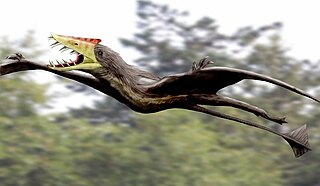 W
WSericipterus is an extinct genus of rhamphorhynchid pterosaur. It is known from the Late Jurassic Shishugou Formation in Xinjiang, China.
 W
WThe Shaximiao Formation is a Middle to Late Jurassic geological formation in Sichuan, China, most notable for the wealth of dinosaurs fossils that have been excavated from its strata. The Shaximiao Formation is exposed in and around the small township of Dashanpu, situated seven kilometres north-east from Sichuan's third largest city, Zigong, in the Da'an District.
 W
WThe Shishugou Formation is a geological formation in Xinjiang, China.
 W
WShishugounykus is a genus of basal alvarezsaurian dinosaur from the Shishugou Formation from Xinjiang in China. The type and only species is Shishugounykus inexpectus. The specific name refers to the unexpected discovery of another species of alvarezsaur from the Shishugou Formation.
 W
WSichuanosuchus is an extinct genus of crocodylomorph from the Late Jurassic and possibly Early Cretaceous of China.
 W
WSinaspideretes is an extinct genus of turtle from the Late Jurassic of China. It is considered the earliest and most basal representative of the Trionychia.
 W
WSinraptor is a genus of metriacanthosaurid theropod dinosaur from the Late Jurassic. The name Sinraptor comes from the Latin prefix "Sino", meaning Chinese, and "raptor" meaning robber. The specific name dongi honours Dong Zhiming. Despite its name, Sinraptor is not related to dromaeosaurids like Velociraptor. Instead, it was a carnosaur distantly related to Allosaurus. Sinraptor and its close relatives were among the earliest members of the Jurassic carnosaurian radiation. Sinraptor still remains the best-known member of the family Metriacanthosauridae, with some older sources even using the name "Sinraptoridae" for the family.
 W
WThe Tiaojishan Formation is a geological formation in Hebei and Liaoning, People's Republic of China, dating to the middle-late Jurassic period. It is known for its exceptionally preserved fossils, including those of plants, insects and vertebrates. It is made up mainly of pyroclastic rock interspersed with basic volcanic and sedimentary rocks. Previously, the Tiaojishan Formation was grouped together with the underlying Haifanggou Formation as a single "Lanqi Formation." Most researchers now agree that the Daohugou Bed, of formerly controversial dating, is a part of the Tiaojishan formation. The Tiaojishan Formation forms a key part of the Yanliao Biota assemblage.
 W
WTienshanosaurus is a genus of dinosaur from the Late Jurassic. It was a sauropod which lived in what is now China. Only one species is known, Tienshanosaurus chitiaensis, which was named and described in 1937.
 W
WThe Tuchengzi Formation is a geological formation in China whose strata span the Tithonian to Berriasian ages. Dinosaur fossils, particularly footprints, have been found from the formation.
 W
WXuanhanosaurus is a genus of theropod dinosaur that lived during the Middle Jurassic of China, around 167.7 to 161.2 million years ago.
 W
WThe Yanan Formation, alternatively spelled the Yan'an Formation is a geological formation in China, it is also alternatively considered a group. The age of the formation is uncertain, with estimates ranging from Toarcian to Bajocian. It is divided up into 5 members, with the designation of Y1 through Y5. Y2, Y3 and Y4 are predominantly dark shales, while Y1 and Y5 are composed of sandstones, coal beds and interbedded mudstones. The depositional environment at the time was when the Ordos Basin formed a large inland lake, surrounded by floodplains. The dark shales have been explored for the potential of producing shale gas. The coal has also been explored for the production of coalbed methane. The formation is also notable for its fossil content, with dinosaur footprints and the remains of the sauropod Lingwulong having been found in the formation.
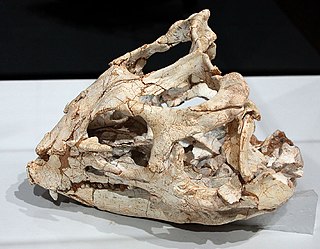 W
WYinlong is a genus of basal ceratopsian dinosaur from the Late Jurassic Period of central Asia. It was a small, primarily bipedal herbivore. Yinlong is the oldest and most primitive ceratopsian known.
 W
WThe Ziliujing Formation is a geological formation in China, It is Early Jurassic in age. It is part of the stratigraphy of the Sichuan Basin. The dinosaur Gongxianosaurus and indeterminate theropod material are known from the Dongyuemiao Member of the formation, as well as dinosaur footprints, Zizhongosaurus and indeterminate prosauropods from the Daanzhai Member The basal sauropod Sanpasaurus is known from the Maanshan Member. An unnamed stegosaur and the pliosauroid plesiosaur Sinopliosaurus are also known from this formation but they were found an indeterminate member. An unnamed teleosaurid known from a complete skull has also been found in the formation, pending a formal description.
 W
WZuolong is a genus of coelurosaur dinosaur which existed in what is now Wucaiwan, Xinjiang Autonomous Region of China during the Late Jurassic period.